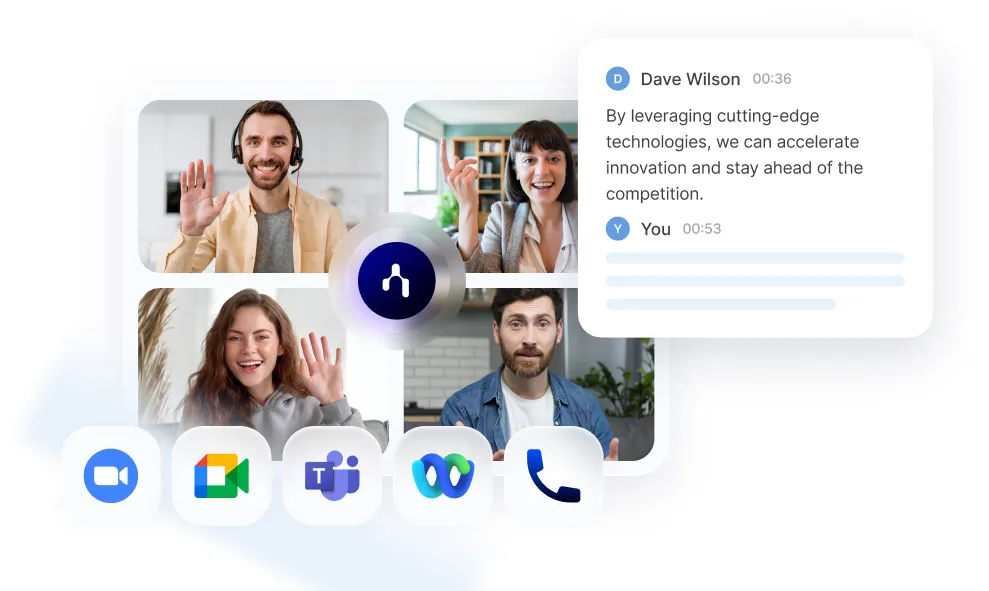1 on 1 Meeting : An Actionable Guide

Get the work done for any meeting
Meeting transcription, AI custom notes, CRM/ATS integration, and more
You’ve probably had one-on-ones that felt flat. The kind where you ask “How’s it going?” and get a shrug.
But when they’re done right, one-on-ones become the most powerful management tool you have.
In this guide, we’ll show you exactly how to make your one-on-one meetings worth it, every single time.
Are One-on-One Meetings Really Worthwhile?
According to Gallup, employees who have regular meetings with their managers are three times more likely to be engaged at work compared to those who don't.
Moreover, these meetings provide a dedicated space for personalized feedback, career development discussions, and addressing concerns that might not surface in group settings. They foster trust and open communication, essential components of a healthy workplace culture.
Critics argue that one-on-one meetings can become platforms for micromanagement. Indeed, poorly conducted meetings can lead to frustration and disengagement. However, the issue lies not in the concept of one-on-ones but in their execution. When structured effectively, these meetings can be powerful tools for alignment and growth.
Organizational psychologist Steven G. Rogelberg emphasizes that effective one-on-ones should focus on both tactical and personal needs of employees. This ensures that meetings are not just about task updates but also about understanding employee aspirations, challenges, and well-being.
One-on-One Meeting Timing & Frequency

One-on-ones only work when they’re consistent. Not reactive. Not optional. Consistent.
Here’s how to get the timing right so your meetings stay valuable—not performative.
🕒 Weekly is the gold standard
If you’re managing a direct report day-to-day, weekly one-on-ones are the most effective cadence.
Why weekly?
- Things move fast in modern teams—especially in marketing, sales, and product. A two-week gap can mean missing critical updates or context.
- Regular meetings reduce pressure to “cram” everything into one check-in. You talk more naturally, not just when there’s a fire.
- They build a reliable rhythm of communication—key for remote or hybrid teams.
Each weekly meeting doesn’t need to be long. 25–30 minutes is often enough. Keep it focused, and make sure it happens—every time.
⏳ Biweekly can work for stable, senior reports
If your direct report is a senior IC or team lead with a stable workload, biweekly can be a solid rhythm—if communication happens elsewhere too (Slack, async updates, etc.).
But beware the trap: biweekly meetings get canceled more easily, and critical feedback can get delayed.
If you’re trying biweekly:
- Keep a shared agenda that builds in between sessions
- Add a 10-minute async check-in midweek if needed
- Don’t miss them—rescheduling is better than skipping
📆 Monthly = maintenance mode (not recommended)
Monthly meetings are too spaced out to address real-time feedback or performance coaching. They work only when the relationship is already strong, and there’s lots of other interaction happening.
But if this is your only touchpoint? It’s not enough. Don’t go monthly unless you’re managing an executive peer or external collaborator.
🧠 Match frequency to team dynamics
- New hire? Weekly—without fail. Early relationships set the tone.
- Underperforming employee? Weekly or even twice weekly, focused on clarity and support.
- High-performing, independent lead? Biweekly can work—with tight follow-through.
Adjust the time, not the commitment. It’s better to meet for 20 minutes weekly than 60 minutes once a month.
What Are the Best Topics to Drive One-on-One Meetings ?

A one-on-one is not a status update. It’s not a checklist. And it’s definitely not where you catch someone by surprise with “We need to talk.”
Here are the topics that actually drive value—and help your direct reports do their best work.
🔍 Personal check-in (but make it meaningful)
Start with the human.
“How are you?” is fine. But “How are you feeling about your work this week?” opens the door to something more real.
Try:
- What’s been energizing you lately?
- What’s felt frustrating or stuck?
- Anything outside of work affecting your focus or bandwidth?
This builds trust—and helps you manage the whole person, not just the output.
🎯 Goal progress and roadblocks
Your direct report has quarterly goals. What’s helping? What’s slowing them down?
Talk about:
- What’s moving forward—and why
- Where they feel blocked or overwhelmed
- Where they need support or a decision to move faster
This isn’t about micromanaging. It’s about clearing the path.
Ask:
“What’s something I can help unblock this week?”
That one question alone can transform your impact as a manager.
💡 Feedback—both ways
One-on-ones are the safest place for honest feedback. Give it. Ask for it. Normalize it.
Offer:
- “One thing you did well this week was…”
- “Next time, here’s something to improve…”
And ask:
- “Is there anything I could be doing better to support you?”
- “Have I been clear about priorities?”
Real feedback builds high-performance cultures—and this is where it starts.
📈 Career development
Even if it’s just 10 minutes, talk about the future.
Try:
- “What skills are you working on right now?”
- “Is your current work aligned with your long-term goals?”
- “What type of project would stretch you next?”
You don’t need all the answers. You just need to keep the conversation going.
Most employees leave jobs because they feel stuck. One-on-ones are where you show them they’re not.
🧠 Reflection and learning
Give space to zoom out.
- “What’s something you learned recently?”
- “If you could redo one thing from last week, what would it be?”
- “What felt like a win worth repeating?”
This shifts the tone from “manager vs. employee” to “we’re building something together.”
One-on-One Meeting Management Best Practices for Actionable Conversations

Let’s be honest—most one-on-ones feel like a formality. They get booked, pushed, rushed, and eventually become 30-minute check-ins where neither person knows what they’re really supposed to talk about.
Here’s how to run one-on-ones that actually drive growth—not just fill calendar space.
🧭 Make the meeting theirs, not yours
Your job as a manager isn’t to drive the agenda. It’s to create the space.
Let your direct report lead the conversation. Ask them to come with topics, questions, or concerns. This isn’t a performance review. It’s their time.
Start with:
“What’s top of mind for you this week?”
“What would be most helpful for us to talk through today?”
When they own the space, they’re more likely to open up—and actually use the time to solve real problems.
📝 Use a shared agenda doc that lives between meetings
The easiest way to turn a one-on-one into something reactive and messy? Walk in with no notes and no structure.
Use a simple shared doc or Notion page that both of you can update. Include:
- Topics to discuss
- Action items from the last meeting
- Links to relevant context (dashboards, projects, feedback)
This creates continuity. It also ensures you’re not starting from scratch every week.
🎯 Don’t just talk about work—talk about growth
If all you’re doing is reviewing tasks and blockers, you’re managing tasks—not people.
Make time for development in every one-on-one. It doesn’t need to be formal. Just ask:
- “What would you like to be doing more of?”
- “Are you learning in your current role?”
- “Is there something you'd like help getting better at?”
These questions show you’re invested—and they help you spot talent before it gets bored or burned out.
💬 Normalize feedback and coaching in every session
Feedback shouldn’t be saved for quarterly reviews. In great one-on-ones, it’s baked into the rhythm.
Try:
- “Here’s one thing I think you did really well this week.”
- “Want some quick feedback on how you handled that handoff?”
- “Can I offer a thought on something I noticed?”
Keep it regular. Keep it kind. And model what a feedback culture really looks like.
✅ End every meeting with clear next steps
No one-on-one should end in ambiguity. Wrap with:
- Recap of what was discussed
- Decisions made
- Who’s doing what by when
Update your shared doc immediately—or even during the call.
This keeps your coaching accountable. And it gives both of you something to look back on and build from.
One-on-One Meeting Agenda & Minutes Template
Here’s a simple, flexible one-on-one template you can copy and adapt to fit your workflow—whether you’re a manager, a team lead, or a founder juggling everything.
📝 One-on-One Agenda Template
Name: [Employee Name]
Manager: [Your Name]
Date: [Insert Date]
Time: [Start–End]
Location: [Zoom/Meet/Room]
Meeting Objective:
[Why we’re meeting today — can be high level (“Weekly check-in”), or specific (“Discuss Q3 goals and review new responsibilities”)]
1. Personal Check-In (5 mins)
- How are you feeling this week—workwise and personally?
- What’s giving you energy or taking it away?
2. Wins & Progress (5–10 mins)
- What went well since our last check-in?
- Any recent achievements or highlights worth celebrating?
3. Current Priorities (10–15 mins)
- What are you focused on right now?
- Are there any roadblocks slowing you down?
- Do you need support, resources, or clarity on anything?
4. Feedback & Coaching (5–10 mins)
- What feedback do you have for me or the team?
- Can I offer some feedback from this past week?
- Anything you'd like to try differently going forward?
5. Career Growth & Development (optional, 5–10 mins)
- Are you learning anything new?
- What skills do you want to build next?
- Anything I can do to support your goals or interests?
6. Open Questions & Topics
- [Employee adds anything they want to discuss in advance]
- [Manager adds any high-priority topics here]
7. Recap & Action Items (5 mins)
- Confirm what was agreed on
- Assign owners and due dates
📄 One-on-One Meeting Minutes Template
Date: [Insert Date]
Attendees: [Employee + Manager Name]
Highlights:
- [e.g. Team campaign wrapped up with great results—CTR improved 30%]
- [e.g. Discussed tradeoffs in shifting focus to product marketing next sprint]
Decisions Made:
- [e.g. Employee will take ownership of launch calendar starting next month]
- [e.g. Move weekly growth review to Fridays at 11am]
Action Items:
TaskOwnerDue DateShare updated Q3 goals draft[Employee][MM/DD]Introduce employee to UX team lead for collab[Manager][MM/DD]
Follow-Up Topics for Next Meeting:
- [e.g. Review campaign brief draft]
- [e.g. Check in on new OKRs]
AI One-on-One Meeting Notes & Follow-Up: Noota

One-on-ones work best when there’s continuity. You follow up. You remember what was said. You track progress over time. But let’s be honest—after a long day of meetings, who has time to take perfect notes and send polished recaps?
That’s exactly where Noota becomes your secret weapon.
- Real-time transcription, without distractions : Noota listens in on your one-on-one (with permission), and transcribes the full conversation with speaker identification.
- Action items—captured automatically ! Noota goes beyond transcription. It uses AI to detect and highlight action items
- One-click follow-up summaries After the meeting, Noota generates a clean, shareable summary.
You want to drive more actions from your 1-on-1 meeting ? Try Noota for free now.
Get the work done for any meeting
Meeting transcription, AI custom notes, CRM/ATS integration, and more
Related articles

Forget note-taking and
try Noota now
FAQ
In the first case, you can directly activate recording as soon as you join a videoconference.
In the second case, you can add a bot to your videoconference, which will record everything.
Noota also enables you to translate your files into over 30 languages.

.svg)
.svg)
.webp)

.png)


.svg)
